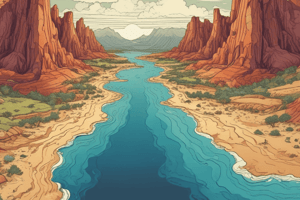Podcast
Questions and Answers
What geological feature is formed when tectonic plates move apart?
What geological feature is formed when tectonic plates move apart?
- Mountains
- Volcanoes (correct)
- Hot spots
- Earthquakes
What causes the formation of the Hawaiian Islands?
What causes the formation of the Hawaiian Islands?
- Mantle plumes
- Hot spots (correct)
- Convergent plate boundaries
- Tectonic plate movements
Where do most earthquakes occur?
Where do most earthquakes occur?
- Mantle plumes
- Hot spots
- Plate boundaries (correct)
- Mountain ranges
What geological force is created from plate movements and leads to earthquakes?
What geological force is created from plate movements and leads to earthquakes?
What did Alfred Wegener hypothesize in the late 1800s?
What did Alfred Wegener hypothesize in the late 1800s?
What did scientists use their knowledge of to form the theory of plate tectonics?
What did scientists use their knowledge of to form the theory of plate tectonics?
What process occurs at divergent plate boundaries?
What process occurs at divergent plate boundaries?
What evidence supports Henry Hess's theory of seafloor spreading?
What evidence supports Henry Hess's theory of seafloor spreading?
Flashcards are hidden until you start studying
Study Notes
- Wegener's hypothesis about continental drift was supported by the discovery of fossil remains of the same species on different continents, such as Lystrosaurus in Africa and Antarctica.
- This mammal-like reptile could not have swam across oceans, making the discovery of its fossils on different continents an intriguing puzzle.
- Wegener proposed the idea of "continental drift" in the early 20th century but was unable to prove it or gain acceptance from other scientists.
- Fifty years later, Henry Hess proposed the idea of seafloor spreading, a process that explained Wegener's continental drift hypothesis.
- Seafloor spreading occurs when molten material enters mid-ocean ridges, creating new oceanic crust, and old crust is pushed outward and eventually sinks back into the mantle.
- Several pieces of evidence support Hess's theory, including the existence of volcanoes, magnetic stripes in oceanic rocks, and the ages of oceanic rocks.
- Earth's poles have reversed many times during Earth's life, and these "striped" seafloor rocks, also known as magnetic reversals, hold a record of these reversals.
- Three mechanisms cause plate movement: mantle convection, ridge push, and slab pull.
- Mantle convection occurs when heated rocks in the mantle become less dense and rise to the surface, while cooler parts sink.
- Ridge push occurs as new oceanic crust forms at mid-ocean ridges and pushes older crust away.
- Slab pull occurs as dense tectonic plates sink beneath less dense plates and create a pull on the rest of the plate behind it.
- There are three types of plate boundaries: divergent, convergent, and transform.
- Divergent boundaries occur when two plates move away from one another, creating a deep crack on land or mid-ocean ridge.
- Convergent boundaries occur when two plates collide with each other, resulting in continent-continent collisions or continent-ocean collisions.
- Transform boundaries occur when two plates slide past one another horizontally, creating earthquakes and causing friction.
- Plate movement can cause various changes on Earth, including volcanic activity, earthquakes, mountain building, and even the movement of entire continents over millions of years.
- Once thought to be a single landmass, Pangaea, Earth's continents have moved apart to form the individual continents we know today.
- Tectonic plate movement is caused by various processes such as mantle convection, ridge push, and slab pull.
- Mountains can form through folding, volcanic activity, or faulting.
- Plates move at a very slow rate of one to ten centimeters per year, and the Earth's crust is constantly changing due to plate movements.
Studying That Suits You
Use AI to generate personalized quizzes and flashcards to suit your learning preferences.




